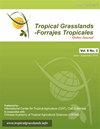亚热带牧草根系生产受品种同一性和落叶严重程度的调节
IF 0.7
4区 农林科学
Q3 AGRICULTURE, DAIRY & ANIMAL SCIENCE
引用次数: 1
摘要
草地占有大量土地面积,占全球土壤碳储量的很大比例,但放牧和基因型组成对地上根生产关系的直接影响尚不清楚。这种认识的缺乏阻碍了管理草原根系产量预测模型的发展,而根系产量是确定土壤碳储量的关键变量。在美国南佛罗里达州的一个普通园林环境中,我们量化了四季落叶处理对广泛种植的牧草(Paspalum notatum fl本文章由计算机程序翻译,如有差异,请以英文原文为准。
Root production in a subtropical pasture is mediated by cultivar identity and defoliation severity
Grasslands occupy significant land area and account for a large proportion of the global soil carbon stock, yet the direct effects of grazing and genotypic composition on relationships between shoot and root production are poorly resolved. This lack of understanding hinders the development of models for predicting root production in managed grasslands, a critical variable for determining soil carbon stocks. We quantified the effects of season-long defoliation treatments on both shoot and root production across 4 cultivars of a widely planted pasture grass species (Paspalum notatum Flüggé) in a common garden setting in South Florida, USA. We found that infrequently applied (4 weekly) severe defoliation (to 5 cm) substantially enhanced shoot production for all cultivars, while severe defoliation reduced root production across cultivars, regardless of frequency. Overall, there was no significant relationship between shoot and root production. Our results showed that above-ground and below-ground productivity are only weakly coupled, suggesting caution against use of simple above-ground proxies to predict variations in root production in grasslands. More broadly, our results demonstrated that improved modeling and management of grasslands for below-ground ecosystem services, including soil carbon sequestration/stocks, must account for intraspecific genetic variation and responses to defoliation management.
求助全文
通过发布文献求助,成功后即可免费获取论文全文。
去求助
来源期刊

Tropical Grasslands-Forrajes Tropicales
Agricultural and Biological Sciences-Agronomy and Crop Science
CiteScore
1.60
自引率
0.00%
发文量
36
审稿时长
16 weeks
期刊介绍:
The Journal publishes, in English or Spanish, Research Papers and Short Communications on research and development, as well as contributions from practitioners (Farmer Contributions) and Review Articles, related to pastures and forages in the tropics and subtropics. There is no regional focus; the information published should be of interest to a wide readership, encomprising researchers, academics, students, technicians, development workers and farmers.
In general, the focus of the Journal is more on sown (''improved'') pastures and forages than on rangeland-specific aspects of natural grasslands, but exceptions are possible (e.g. when a submission is relevant for a particularly broad readership in the pasture and forage science community).
The Journal will also consider the occasional publication of associated, but closely related, research in the form of an additional scientific communication platform [e.g. a re-make of the former Genetic Resources Communication series of the former Division of Tropical Crops and Pastures of the Commonwealth Scientific and Industrial Research Organisation (CSIRO), Australia].
Areas of particular interest to the Journal are:
Forage Genetic Resources and Livestock Production[...]
Environmental Functions of Forages[...]
Socio-economic Aspects[...]
Topics within the aforementioned areas may include: Diversity evaluation; Agronomy; Establishment (including fertilization); Management and utilization; Animal production; Nutritive value; Biotic stresses (pests and diseases, weeds); Abiotic stresses (soil fertility, water, temperature); Genetics and breeding; Biogeography and germplasm collections; Seed production; Ecology; Physiology; Rhizobiology (including BNF, BNI, mycorrhizae); Forage conservation; Economics; Multilocational experimentation; Modelling.
 求助内容:
求助内容: 应助结果提醒方式:
应助结果提醒方式:


